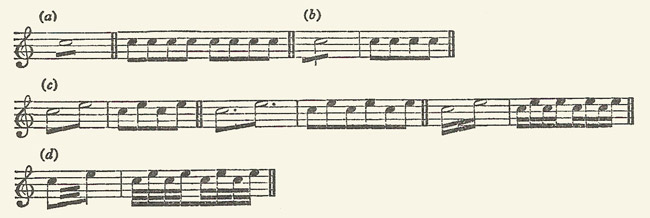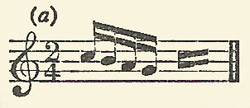repeat marks

Figure 1.

Figure 3.

Figure 4.

Figure 5.
To avoid needless writing (especially in orchestral music) the repetition of a short passage is often indicated as shown in Figure 2 (below) and Figure 3:
 |
| Figure 2. |
Sometimes when a section is marked to be repeated it ends in a way suitable for the return to the beginning, and, having been repeated, ends in a way suitable to proceed to the next section (or to close the whole composition if nothing more follows). The two endings are then shown as in Figure 4.
Or instead of the '1', there may be used the expression '1ma Volta', or 'Prima Volta", or "1st Time'. And instead of the '2' may be used the expression '2da', or 'Seconda Volta', or '2nd Time'.
When a return to the opening of the piece, or of some section of it, is indicated but only a part is to be repeated and then the piece brought to an end, the word Fine (end) shows where to stop. For instance, a minuet is often followed by another minuet called 'Trio', after which the first minuet is to be repeated and then an end to be made. In this case the word 'Fine' is placed at the end of the first minuet to indicate that this is the place to conclude when performing the repetition.
Repeat marks for notes
There is a 'catch' in (c) and (d) (Figure 4), the convention not being quite logical. In (c) (three examples are given) the time-value to be filled is that of one of the notes shown (in this case a half-note); in (d) the time-value to be filled is that of both of the notes shown (in this case eighth notes).
Note: If Tremolo (or Trem.) is added to any of the above or similar signs, the notes concerned should be repeated very rapidly and without any attention to the exact number of repetitions attained during the time-value available.


